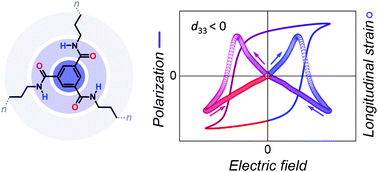Negative piezoelectric effect in an organic supramolecular ferroelectric†
Abstract
The vast majority of ferroelectric materials demonstrate a positive piezoelectric effect. Theoretically, the negative piezoelectric coefficient d33 could be found in certain classes of ferroelectrics, yet in practice, the number of materials showing linear longitudinal contraction with increasing applied field (d33 < 0) is limited to few ferroelectric polymers. Here, we measure a pronounced negative piezoelectric effect in the family of organic ferroelectric small-molecular BTAs (trialkylbenzene-1,3,5-tricarboxamides), which can be tuned by mesogenic tail substitution and structural disorder. While the large- and small-signal strain in highly-ordered thin-film BTA capacitor devices are dominated by intrinsic contributions and originates from piezostriction, rising disorder introduces additional extrinsic factors that boost the large-signal d33 up to −20 pm V−1 in short-tailed molecules. Interestingly, homologues with longer mesogenic tails show a large-signal electromechanical response that is dominated by the quadratic Maxwell strain with significant mechanical softening upon polarization switching, whereas the small-signal strain remains piezostrictive. Molecular dynamics and DFT calculations both predict a positive d33 for defect-free BTA stacks. Hence, the measured negative macroscopic d33 is attributed to the presence of structural defects that enable the dimensional effect to dominate the piezoelectric response of BTA thin films.



 Please wait while we load your content...
Please wait while we load your content...